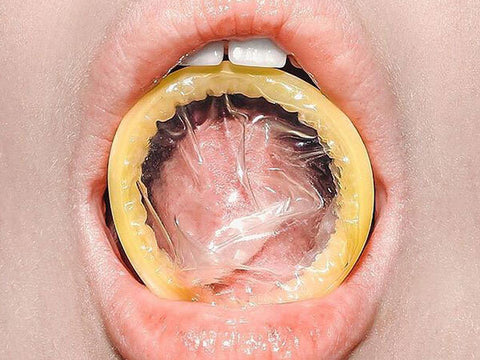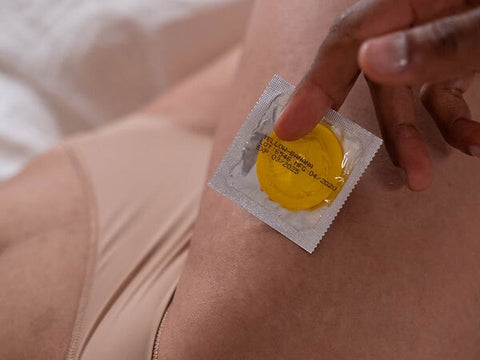How to Choose the Right Size Condom
Choosing the wrong size condom is one of the main reasons why condoms turn out to be uncomfortable to those who have a penis.

If it often breaks (this happens to 7% of women*), curls or slips out, the most common reason is wearing the wrong condom size.
Condoms are one of the biggest inventions of recent times, but it is also the most hated. Only 27% of people interviewed said they used a male condom the last time they had sex. And 14% said that on at least one occasion, they had not used a condom during sex because they don’t like how it feels. Most worryingly, 1 out of 10 sexually active 16 to 24 year olds said they had never used a condom.

It’s been 175 years since “modern” condoms were invented and no one has found another solution (handy or accessible) to protect us from STIs and not just pregnancies.
We took a few steps forward when we created the female condom (worn by someone who has a vagina). We have also worked on new materials beginning with rubber (the material of the first condom, invented in 1839) then moving to latex, polyurethane and polyisoprene (made without some latex proteins that can cause allergy). We have even explored flavoured condoms, to spice up oral sex. It is important that oral sex is performed with some kind of condom or protective barrier, even if only 26% of people uses it*. Finally we have phosphorescent condoms - this one reminds us of Star Wars lightsabers!
+ Find the perfect condom for you
So how do you choose the right size condom?
You need to start with measurements: circumference of the penis. If you have never measured it, it’s about time. A rough guess isn’t enough!
We are not referring to regular sizes (small, medium etc.) but sizes from 47 to 69 that correspond to centimetres, so you can easily measure your penis without any stress.

You’ll need an erection and a measuring tape - like a tailor’s tape measure or a flexible one to wrap around your penis to measure the circumference. For example, a size 47 is for a penis circumference ranging from 9.5 to 10cm. The biggest, size 69, is for a circumference ranging from 14 to 15cm.
When talking about condom sizes we are not referring to the length of the penis! This is a common mistake, because a lot of people believe that bigger sizes refer to longer penises, but that’s not entirely true (unless it’s a penis of a larger size).
You’ll always find references to sizes, also known as nominal width, written somewhere on the condom package.
These instructions refer to male condoms. If you want to use a female condom, things get easier as there are no sizes.
Facts and important information about condoms
Removing or damaging a condom purposely during sexual intercourse, without consent from your partner (this act is called stealthing) is considered sexual abuse and classified as rape. When talking about explicit consent, we refer to having verbally expressed the willingness to remove the condom and having received a positive answer. Removing the condom exposes both partners to the risk of getting STIs or getting pregnant. It also shows a lack of respect and trust towards the person, who gave consent to protected intercourse.

The condom is the only way to prevent getting STIs. This applies to everyone, regardless of sex or sexual orientation. There are male and female condoms. The condom must be worn during the entire duration of sexual intercourse, not only during penetration.
________________________________________________________________
You may also like: Sex Education - ep. 4: Staying safe: a guide to preventing STIs
________________________________________________________________
The condom is a contraceptive and it prevents unwanted pregnancies. This doesn’t mean that entering menopause allows you to stop using condoms. STIs can be transmitted at any age.
Condoms are not always compatible with the use of lubricants therefore could potentially break. For example, latex condoms can’t be used with oil-based lubricants. So make sure to read the packaging before you use them.
If you experience any pain, itchiness or redness using condoms, you could be allergic to latex.
Condoms are disposable. If you’ve accidentally put it on inside out, throw it away and get a new one. Remember to always squeeze the tip of the condom while rolling it down your penis.

If during the same intercourse there are several partners, it’s important to change condoms after every penetrative act with a single person, before penetrating another.
If during sexual intercourse you want to switch from vaginal to anal penetration, it’s important to change the condom, especially after the anal one, if you choose to carry on.
Condoms should be thrown away in the mixed waste and not flushed!
There’s always an expiry date, so be sure to check it. Do not keep them near any source of heat, as it can alter their effectiveness.
Protecting yourself is your right; if someone tries to convince you to not use a condom, such as saying things like “if you’d love me, you would do it…”, remember that this is coercion.
* Copen 2017




